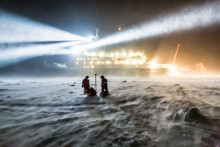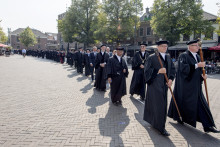‘It is a big deal. It is dangerous,’ says the polar researcher. Originally from India, Vishnu Nandan is an expert on remote sensing of Arctic and Antarctic sea ice, currently working as a post-doctoral researcher at the University of Manitoba, Canada. ‘Most importantly, however,’ he adds. ‘I’m a proud ITC alumnus.’ Nandan obtained his Master degree in Geoinformatics at the University of Twente in 2012.
Now, a few short years later, he was invited to be part of the MOSAiC project, the largest ever expedition to the Arctic, where hundreds of scientists will collect data to better understand global climate change. On Friday, the 22nd of November, Nandan is beginning his long journey and will join the research icebreaker Polarstern currently anchored close to the North Pole. He will not see daylight until March when he returns home.
mosaic EXPEDITION
MOSAiC is the biggest polar expedition ever attempted. It started in September 2019, when the German research icebreaker Polarstern left the safety of the harbor in Tromsø, Norway, to spend a year drifting through the Arctic Ocean. It is the first year-round expedition into the central Arctic exploring the Arctic climate system also during the polar winter. Due to the harsh working conditions, the experts on board exchange in phases (but always include at least six polar bear guards).
With the total budget of over 140 million euros, the expedition aims to collect unprecedented data and to better understand the Arctic climate system as the epicenter of global warming. As an end result, the project will provide scientific basis for policy decisions on climate change mitigation and adaptation.
Photo of Polerstern currently anchored near the North Pole. Photo by Alfred-Wegener-Institut / Stefan Hendricks (CC-BY 4.0)
The expedition already started in September, but you are leaving this week. How will you get there? I understand that the main research icebreaker Polarstern has already anchored.
Nandan: ‘That is correct. The ship has already anchored. It will freeze into the surrounding sea ice and move together with the ice piece. The expedition is divided into six legs and I’m joining the second one. I’m first flying to Tromsø where I will get on a Russian icebreaker. It will drop us off at Polarstern and it will pick us up again in February. The trip from or to Tromsø already takes 15 to 20 days which means I will not be back until March.’
What will be your role in the MOSAiC expedition?
‘The goal of this international expedition is to provide the next generation of scientific data to improve climate models. Through a year round observation, we will study all possible components that govern the Arctic environment: the atmosphere, the ecosystem, the ocean, the ice and so on. I’m one of the few experts who know how to deploy high-resolution, surface based radar sensors on ice. My scientific role will be to lead the deployment and collection of radar data, which will allow us to monitor changes in snow and sea ice thickness. Secondly, I will be helping other teams focused on collecting other data.’
 Photo by: Alfred-Wegener-Institut / Esther Horvath (CC-BY 4.0)
Photo by: Alfred-Wegener-Institut / Esther Horvath (CC-BY 4.0)
What got you into polar research in the first place?
‘That credit goes to ITC. My thesis was on radar remote sensing of mangrove forests, and as an expert on radar remote sensing I got an offer from the Alfred Wegener Institute in Germany to study the Antarctic ice sheets. Later on, I did my PhD research on sea ice, which was even more challenging and exciting.’
What excites you about this work?
‘The field work! I’ve been to the Arctic and the Antarctic about sixteen times. I come from South India, where nobody has seen snow or ice in literally ten thousand years, so to be able to visit the polar regions is simply great. From the scientific point of view, sea ice is very challenging and I love this challenge.’
 Photo of the expedition crew installing a trip wire around the icebreaker. Photo by: Alfred-Wegener-Institut / Esther Horvath (CC-BY 4.0)
Photo of the expedition crew installing a trip wire around the icebreaker. Photo by: Alfred-Wegener-Institut / Esther Horvath (CC-BY 4.0)
What is it like to be in the Artic?
‘It looks like a white dessert and it is amazingly silent. There is this profound silence. However, the experience largely depends on where and when you go. In summer you have 24 hours a day sunlight and it is not so cold, it is actually T-shirt weather. In the winter, though… first of all, it is completely dark and it is insanely cold. It can get down to about -50°C. It is very challenging, also emotionally challenging, because you can’t see your loved ones for a few months. It is scary. It is no man’s land and there is a constant threat of polar bears.’
How do you deal with that?
‘I know how to shoot and there are five or six polar bear guards who keep an eye on it. You must remember, though: it is completely dark. You need infrared cameras to see if a polar bear is even approaching. These expeditions are dangerous. It is a big deal. For me, the MOSAiC expedition will probably be the most technically and the most personally challenging one yet.’
 Photo taken from the Polarstern icebreaker showing the threat of polar bears is indeed real. Photo by Alfred-Wegener-Institut / Esther Horvath (CC-BY 4.0)
Photo taken from the Polarstern icebreaker showing the threat of polar bears is indeed real. Photo by Alfred-Wegener-Institut / Esther Horvath (CC-BY 4.0)
What will be some of these challenges?
‘There is the scientific challenge. All instruments need to be deployed on ice. If the ice breaks off, we need to retrieve the instruments very quickly otherwise they fall into the ocean. Then there is the logistical challenge of deploying instruments on ice in complete darkness. Moreover, since it’s really cold, you have to pray to all the gods that the instruments will even start running. And then there is of course the personal challenge. You are in complete dark, you lack vitamin D, your loved ones are far away and you can’t see them due to the weak communication signals. You are literally stuck and can’t go back. There is a doctor on board in case of medical emergencies, but it would take days to get to the shore or for help to come to us.’
Despite all this, you are going. Are you more terrified or excited?
‘Definitely excited!’
What do you hope to achieve in your time on the expedition?
‘For me, the biggest thing about this expedition is that we’ve never before had high resolution data of sea ice. This is really precious data. Through analyzing it, we want to explain the geophysical condition of sea ice and how it has been changing under warming Arctic conditions which we are currently experiencing. This way we contribute to the global climate models. The Arctic is the key area of global climate change. Our data can help find a way for managing our development sustainably.’
This isn’t the last time we will hear from Vishnu Nandan. You can look forward to his monthly blog posts directly from the board of Polarstern, describing the daily life in the Arctic and his scientific endeavors.

Vishnu Nandan








